Editor’s Note: As those of you who have followed this sugaring season journal over the past two seasons are well aware, it’s hard for me to keep things in real time. During big runs I’m nowhere near a computer (thankfully), and so blog entries are posted in fits and spurts when the weather and work load allow. To try and make things more consistent, I’ve given myself some lead time this year, and will try to post updates every Friday, Monday, and Wednesday over the course of the season. Thanks for reading, and do participate and share how you’re doing with your own sugaring operation.
February 2.
Overcast. 25°F at 5 p.m. I’m sitting in camp on the eve of sugaring season, and the walls are just starting to absorb the wood stove’s heat after a month of straight cold. Venison stew bubbles on the antique range. Blue light falls through the windows. An oil lamp on the pine table wards off the gloaming.
In front of me sits a battered copy of The Living Wilderness magazine from December 1980. In it, novelist and environmentalist Wallace Stegner quotes another writer, Sherwood Anderson, saying:
“Is it likely that when the country was new and men were often alone in the fields and the forest they got a sense of bigness outside themselves that has now in some way been lost . . . Mystery whispered in the grass, played in the branches of trees overhead, was caught up and blown across the American line in clouds of dust at evening on the prairies . . . I am old enough to remember tales that strengthen my belief in a deep semi-religious influence that was formerly at work among our people. . . I can remember old fellows in my home town speaking feelingly of an evening spent on the big empty plains. It had taken the shrillness out of them. They had learned the trick of quiet.”
Stegner was using the quote to advocate for more federally designated wilderness areas – this was all part of his campaign to keep humans from completely domesticating themselves. But with respect to his advocacy and cause – a noble one – I don’t think you need true wilderness to feel what he’s referring to.
I just spent the last few hours walking our 40-acre “farm” bush – one of two sugarbushes we tap each year. Man’s influence can be seen everywhere here:in the piles of maple bolts I cut and split during a thinning last winter, in the forest composition that my father has been skewing since the early 1980s, in the hand-punched tin signs left by Colonel Fairfax Ayers in the 1960s, in the faint wagon trails that might have been made by Gertrude Bates in the 1920s, in the stone walls that were probably constructed by Abel Webb in the 1870s, and in subtle signs left by who knows how many others before that. Squint your eyes near the old spring in the south end of the bush, the one that gurgles from a limestone seam in the earth, and see a crude lean-to with a blanket for a door, or a small house made of unhewn logs. Dirt floor.Oiled-paper windows.A scarf of smoke rising from a split-stock chimney. Some pioneer in the middle distance hacking away at the pre-colonial forest in an attempt to bathe the land in light.
The point is that these woods still feel big and empty to me, even without being wilderness. These mysteries Anderson referred to – human and otherwise – are held solemnly by the trees and the wild, transient winds that animate them. The forest has been shaped by human hands for at least 250 years, and probably a good deal longer than that. And yet the place has never been domesticated. Its spirit – its sense of bigness – is very much intact, something that’s not lost on the men and women who have worked it and continue to work it.
I’m in camp tonight to let the shrillness drain out of me. To remember the trick of quiet before the next few months of frenzy. Friends will be in later this evening and tomorrow we’ll descend upon the sugarwoods, drills in hand, to poke the year’s first holes. With luck we’ll get around 2,800 trees tapped before the year’s first run. With luck the sap will be sweet, the weather consistent. We’ll boil into April. On the eve of sugaring season everything is as it’s supposed to be, and anything is possible.

February 3, 2013
Sunny. Low twenties. Four of us worked in the bush today, fixing lines as we went, and all told we got around 500 trees tapped. The low snow depth made walking through the woods a breeze – a guilty pleasure, for sure.
If you had asked me 10 years ago if it was a smart idea to be tapping in below-freezing weather at the beginning of February, I would have, without any hesitation, said no. Part of this confidence can be chalked up to youth – you know everything when you’re 27 – but part is conventional wisdom based on the way sugaring used to be practiced. In the old days when people used buckets, you’d get four to six weeks out of a taphole before it stopped flowing. Statistically speaking, the best window for the freeze/thaw cycles you need for a sap run is in March, so tapping in early February would have been jumping the gun considerably.
Technological advances in the past 30 years have widened the sap-making window. Improved tubing systems and innovative new spouts limit microbial contamination in a taphole, which, weather permitting, keeps the holes running longer. With a clean tubing system, it’s possible to tap in January and collect sap through April – all of the big producers do it this way.
But, of course, there are pros and cons with everything. Tubing systems may be air tight, but unless they’re brand new they’re not sterile; when you tap early, and you get a freak warm spell in February, your holes are being exposed to microbes even in a tubing system, which degrade the quality of the sap and sap flow.
I also wonder if tapping trees in really cold weather increases the risk of risk of frost cracks around the taphole, especially in smooth-barked trees. I don’t know for sure that it does, but it makes a certain amount of sense to me that boring and pounding into frozen wood might increase your risk, as would the wild temperature swings associated with a 50° February warm spell followed by a -20° cold snap, something that’s certainly not unheard of in Northern New England. Above find a picture of a particularly ugly frost crack around an old taphole – the bark was peeled away to reveal the extent of the damage.
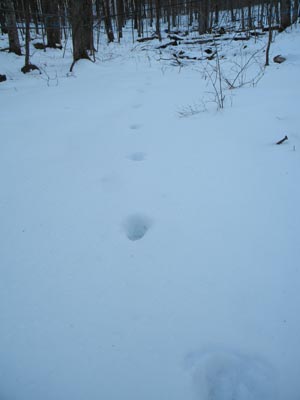
A fox walks up a frozen stream in the farm bush.
February 27, 2013
We’ve worked hard tapping over the last two weeks and the 1,600-tap farm bush is just about done. We moved up to the Hall bush on Maple Hill last Sunday and tapped 600. On Monday and Tuesday we added another 400. We should be tapped out by the end of the week. The weather has been perfect – warm enough to be comfortable in the woods but not so warm that we’re missing much.
It ran a bit yesterday and trickled through last night. We collected 1,700 gallons of sap from the farm this morning – a stormy, wet morning that had us dressed head to toe in rain suits. Thus far it’s been an elevational storm – snow above 1,000 feet, rain and sleet in the valleys. I’m off to boil the first sap of the year.
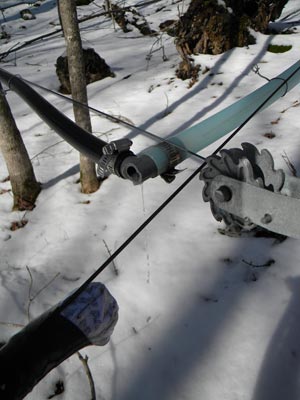
March 1, 2013
The linework continues, as evidenced by this picture here. We’re closing in on being tapped, but there are a lot of major issues in the woods still. Lots of sap is just pouring on the ground. On the bright side, we made 15 gallons on 2/27 and another 40 or so last night. The niter is so fine in the syrup we’re having trouble filtering it. More soon.
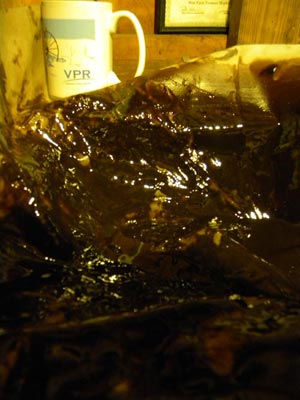
This year's black, oily sugar sand.
March 8, 2013
When sugarmakers talk to each other about how their season is going, they don’t generally talk about how many gallons of syrup they’ve made because that number doesn’t mean much without context. Someone with 100 taps who makes 50 gallons of syrup in a season had a smashing year; someone with 10,000 who makes 500 gallons had a terrible one. And so we set a baseline for what constitutes a good season – traditionally this benchmark has been a quart of syrup per tap – and call this arbitrary number our “crop.” Then we express how we’re doing as a percentage of this goal. Last year we made 70 percent of a crop. In 2003 we made 40 percent of a crop. On years when we exceed our goal (over the last decade we’ve exceeded it three times – in 2004, 2008, and 2011), we don’t say we made 120 percent or whatever, we simply say that we “had a good year.” Like dairy farmers, maple farmers are very adept at talking about when things are rough, but not so good at communicating success.
We’re up to 123 gallons of syrup for the year, so we’re at about 20 percent. Statistically speaking, we’re doing well. Sugaring season, as most of you know, is entirely dependent on the weather – specifically, the number of freeze/thaw cycles that occur once a tree has been tapped. Our season typically peaks in mid-March and ends in early April, which gives us a good jag of time yet. Of course last season we were on track to break all kinds of records, and then things just up and ended on March 13, so no one is feeling complacent.
People often talk about the perfect sugaring weather being low pressure (because sap flow is dictated by the difference between the internal pressure of a tree and the pressure outside), with a daytime high of about 45°F following a low of about 28°F. And while this describes the conditions for an optimal “run,” this year’s weather has me rethinking the idea of perfect. Over the past few weeks, daytime highs have been consistently averaging about 38°F, and the sap really hasn’t run in any aggressive way. Truth be told, this has been really wonderful. We’re only making about 20 gallons of syrup each time we fire the evaporator, instead of the 80 gallon days we’d have if it was 10 degrees warmer, but the up side is we’re not working 18 hour days. We do bread work until mid-morning, collect and start boiling by early afternoon, finish up boiling in the early evening and still make it home for supper with the family. We wake up refreshed and ready to do it all again. This manageability and consistency has been really sweet.
We’re making medium amber, but as a general rule our syrup is significantly darker than it was last year, when our first 200 gallons were fancy grade. Last year’s light syrup had light sugar sand – almost pure white. In contrast, this year’s sand is black and oily and hard to get out of the syrup. (Sugar sand, for those who don’t know, is a naturally occurring precipitate that forms as you cook sap. It’s composed primarily of calcium and magnesium compounds, commonly calcium malate.)
Are any of you other sugarmakers having a similar experience?
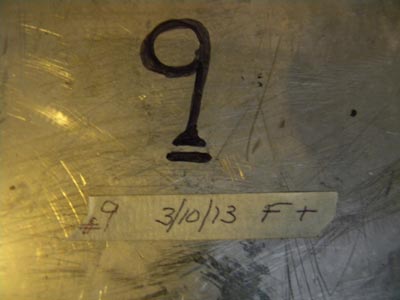
A drum of this year’s syrup.
March 12, 2013
The sap poured for much of the weekend, which set us up for a big weekend. Josh Criss worked up in the sugarbush chasing leaks, Dad and I took turns collecting and boiling. A phalanx of family and friends stopped by to lend a hand. It never froze Sunday night, and so it didn’t run much to speak of on Monday. This was just as well, as it gave us a chance to catch up. We fired the rig yesterday morning around 7 and when we shut it down around 7 we’d made 90 gallons of fancy syrup. That’s almost eight gallons an hour on an evaporator that’s rated for two. “We were really pushing it,” Dad said to me at the end of the day with a smile and tired eyes.
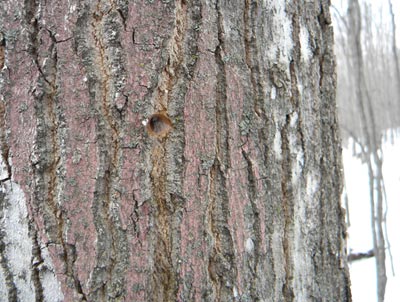
March 19, 2013
We’re between 50 and 60 percent of a crop, and waiting out the recent cold snap. We used the time to cut firewood – between the sugaring operation and my immediate family we burn about 36 cords a winter – so there’s always wood work to be done. Josh Criss and Dad fixed vacuum leaks at Hall yesterday and have that vacuum at 23 inches – a few more lines and they’ll have it at 25, which is about as good as it gets. Now, we wait out the snow, which as I write this is falling steadily. Pretty late winter snow – the kind that makes you love winter even though you’re starting to get sick of it.
March 23, 2013
It won’t be long now until baseball season starts, which in southwestern Vermont means John Sterling and Suzyn Waldman on the radio calling Yankees games. I don’t even like the Yankees but I like both of these announcers, so I listen semi-religiously. Sterling is a showman, known primarily for his bombastic homerun calls - you can hear audio clips here. But he also has a habit of turning to Suzyn at least five times a game, when the number nine hitter gets a key hit, or an ace gets shelled, or a player gets hurt, or a fielder makes a great play, or someone makes an error, and saying: “You know, Suzyn, you just can’t predict baseball.”
I often feel like Sterling when I talk about sugaring, because you just can’t predict that either. Are you guys going to be boiling next weekend? Is the cold snap going to hurt your season? Is this year going to be better than last year? You know, Suzyn, you just can’t predict sugaring. Like a broken record, over and over again.
We haven’t boiled a drop of sap since March 15, which is disappointing in a production sense but a cool illustration of how you know Suzyn you just can’t predict sugaring. Last year we started boiling on February 19th, and enjoyed pretty consistent weather until March 8, when it started to warm up. It warmed up gradually at first – daytime highs in the 40s crept into the 50s and then the 60s. By March 13 the sap had stopped running, and then, the weather just got stupidly hot and everything was over.
This week last year (the week of the 18th through the 23rd), the daytime highs in Albany, New York, were 69, 78, 78, 76, 81, and 71 respectively. That’s impossibly warm, and impossible weather to sugar through. Microorganisms are responsible for tapholes closer – they create the gummy film that blocks the wood vessels and stops flow – and sap degredagion – they break down sucrose molecules into glucose and fructose, which then react during the evaporation process to produce dark syrup that at a certain point becomes off flavor. Anytime it gets above fifty degrees the microorganisms multiply rapidly – sap in a bulk can go from looking like water to looking like skim milk in a day. Now imagine two straight weeks of sixties and seventies. Guys were ruining their RO membranes last year trying to force this rancid sap through it and making ropy, off-flavored syrup that was so bad the bulk buyers who buy off-flavored syrup wouldn’t even touch it.
This year the weather also got a little too warm around March 13 – up into the mid fifties. But then the jet stream shifted and Canadian air started funneling into the region and sugarhouses sat idly because the weather was too cold. This past week daytime highs in Albany, New York, were 37, 34, 36, 34, 37, and 39.
So here you have a tale of two seasons, but while both too-cold and too-warm weather can bring a season to a screeching halt, cold is always better. You can’t come back from heat, but the cold just puts things on pause. Now the danger of late-March cold snaps is that when it does warm up it could go right to 60 degrees and we’d be sunk. Our average season end date is April 2, so we start getting a little nervous when we see that on the horizon. But, if things come back and we get another good week or two of sap weather, it could still be: “Season Over. The Sugarmakers win! THE-AH-AH-AH- SUGARMAKERS, WIN!”
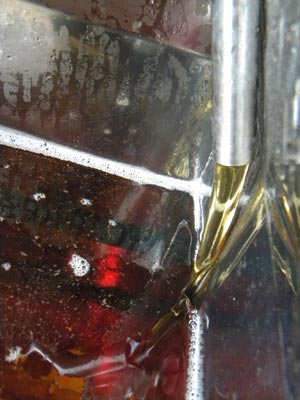
March 27, 2013
We had a nice Maple Open House Weekend this past weekend, though the cold weather had us simmering sap instead of boiling it. Thanks to everyone who stopped by.
The sugaring picked back up with a vengeance Monday, and the sap is still clear and sweet. In fact, we made the lightest syrup of the year Monday night, which prompted a lengthy discussion as to why. I can’t remember ever making fancy syrup that was this light on the last week of March. And while yes, the weather is cold and thus conducive to it, the weather was cold last week and what little syrup we made was dark amber. It was cold at the beginning of the year and what fancy we made was several shades darker than this latest batch. Something seems to have changed in the trees. The sugar sand has gone from black and oily to amber colored to almost white. I talked to a maple researcher about this and he said he’s done and/or seen studies on the chemical composition of sugar sand but doesn’t know why it changes like this. I’ve talked to old timers and they say that when the leaves “ripen on the branches” in fall (i.e. a late frost), the sugar sand will be light and the syrup sweet. If the trees lose their leaves early in fall, you’ll get black sugar sand and strong syrup in spring. As for a season that’s a mix of the two? Well, they’ve seen that, too. There’s no answer in that, but there’s a different kind of wisdom. You’re never going to figure sugaring out, so you’d better just shrug your shoulders and boil sap.
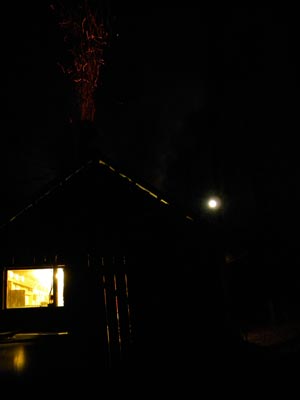
March 29, 2013
The weather was perfect for sap early this past week, and every sugarmaker in northern New England and New York was boiling by the light of the full maple moon. We’ve logged about 26 hours of boiling in the last two days. Still making medium amber.
Sugarmaker Josh Criss washing down the filter press.
April 1, 2013
We made about 300 gallons of syrup last week, which is about half of our projected yearly total. Put another way, in five days we made as much syrup as we had in the previous 28. The lesson here is that you’ve got to be ready to collect the sap when it comes and you’ve got to be patient.
New sugarmakers have a hard time with this – when the season doesn’t conform to their schedule, they’re quick to think the worst. The media also has a hard time with this, as it’s hard to build a story around an endeavor that’s so hard to pin down. A case in point is the maple sugarmaking feature that ran in last Sunday’s New York Times. There are a few blown facts in the piece (for instance, our relatively small RO listed at $24,460 three years ago, so Burr Morse’s presumably much larger machine cost a lot more than $8,000) but it wasn’t a bad story, per say. I was glad to see the writer debunk the assertion that vacuum pumps “suck the life out of maple trees.”
But I think the story, like almost all sugarmaking stories in the mainstream press, puts too much stock in this idea of “sugaring season,” which legend has it starts on Town Meeting day and runs through early April but in reality has never conformed to a strict human schedule. As last week illustrates, you can make a crop of syrup in two weeks if the weather cooperates, and it doesn’t matter if those two weeks come in February, March, or April.
And by filtering a story on technological innovations through the lens of climate change, the writer is burying the lede. How cool is it that technology has progressed to the point where people can make syrup full time. In this era of low sawlog prices, how wonderful is it from a forest conservation angle that syrup has become such a strong non-timber forest product. How great is it that there’s such interest of late in backyard sugarmaking – the additional 1.5 million taps cited in the piece have not all come from commercial producers; sugarmaking is thriving as a rural, and a suburban, rite of spring.
As the planet warms, there may well be a day when sugarmaking isn’t viable in the Northeast. But this day is not imminent, and the reality on the ground is that we’re in the midst of a good sugaring season and a time of unprecedented expansion in the industry. By most measures, things are as good, or better, than they’ve ever been.
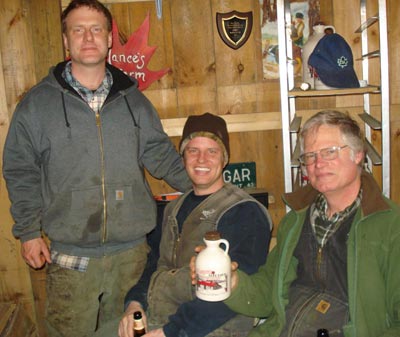
Three tired sugarmakers celebrate a successful year.
April 5, 2013
We made our crop for the season at the end of last week; by Monday evening we’d broken our all-time production record. By Tuesday night we were out of drum space. A sugarmaker up the road is paying .50/gal for delivered sap, so we’re going to keep collecting sap as long as we can and sell it to him as long as he’ll take it. A few buds on the silver maple outside my door have popped, which means this week will probably be it down here.
The snow is long gone from the farm bush and the soil is drying out. The willow that hangs over the pond near the pump house has lemon-yellow branches, and the hillside, from a distance, is rust-colored as the red maples prepare for their annual flower show. The moss on the limestone boulders is shocking green, and if you look closely you can see waves of spore capsules reaching towards the sun. Nothing has emerged from the leaf litter yet, but if you brush away the leaves you’ll see deep greens and reds and purples – a whole gamut of early life. Over at the Hall bush it’s still early spring – though the seasonal stream that runs through the canyon is swollen with runoff and the wet, tired-looking snow is disappearing by the hour.
The first wood frogs of the year are calling from the swamp behind the sugarhouse. We’ve processed about 35,000 gallons of sap this spring, and everything is so impregnated with steam that it smells like we’re still boiling when you get within 100 feet of the place, even though the cupola has yawned vacantly for three days now. The rows of gleaming stainless steel barrels inside, all full of good syrup, make us feel like rich men, even though the bulk price will probably drop in light of the good season and the marketing/sales work has yet to begin. The empty wood shed stares at us expectantly.
What to say about a good year like this? You’ve got to be grateful. Success like this comes maybe a couple times a decade if you’re lucky, so you’d better take the time to smell the flowers. And, I guess, you’ve got to be disciplined. Sugaring, farming, is a crap shoot, and anytime you win big you get that adrenaline shot just like a problem gambler at a casino. Your instinct is to go big, but unless you’re independently wealthy you’d better temper this enthusiasm and remember the 30-percent-of-a-crop years before you take out a $100,000 loan. I keep a quote that I tore out of a newspaper in my wallet, from a story by Amanda Petrusich. It says: “Our capacity for fantasy – for indulging that nagging sense that as good as we’ve got it, there could be something better . . . might be humankind’s greatest burden.” When I shared this with a friend at a bar once he shook his head and said: “I’ll never understand you Irish Catholics.” But I guess I keep it at hand for moments like this.
Thanks, everyone, for reading. On with life.


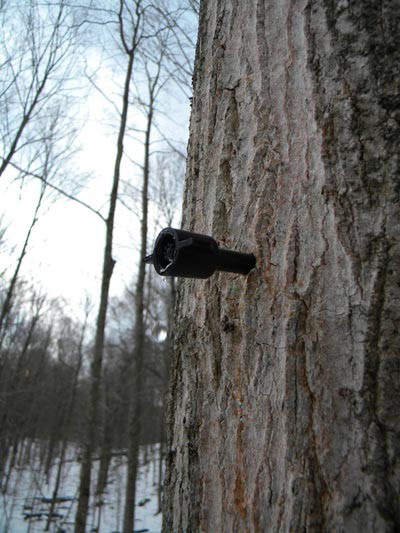

Discussion *